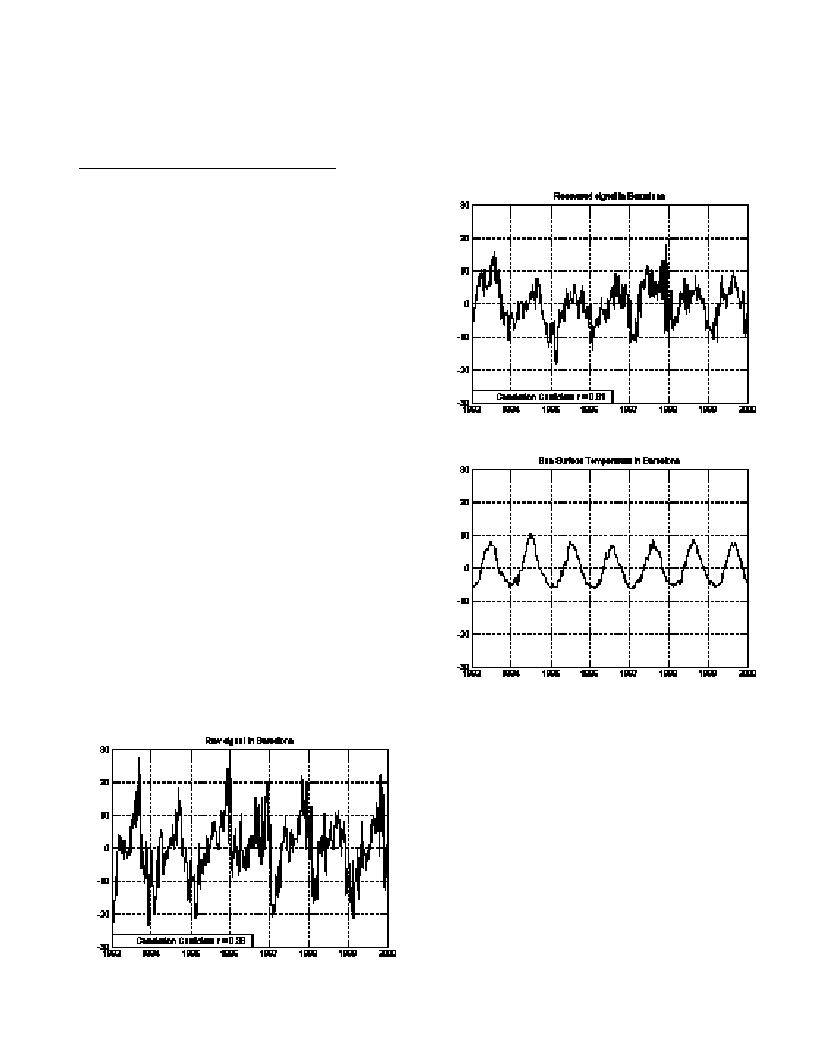Rapp. Comm. int. Mer Médit., 37,2004
100
CANONICAL CORRELATION ANALYSIS TO EXTRACT EXTERNAL INFLUENCES
IN SEA LEVEL AROUND SPAIN
J. García Lafuente
1
, J. Del Río
1*
, Enrique Alvarez
2
, Begoña Perez
2
, J.M. Vargas
1
, F. Criado
1
1
Departamento de FISICA APLICADA II, Universidad de Málaga.
2
Área del MEDIO FÍSICO, Puertos del Estado, Spain.
Keywords: CCA, Sea Level, Temperature, Pressure.
Canonical Correlation Analysis (CCA) is a mathematic technique
[1,2] that uses two datasets, each one consisting of a given number of
time series, in order to look for the canonical functions (or canonical
series) that optimize the relationship between a linear combination of
variables from the first data set and a linear combination of variables
from the second data set. The technique provides ensembles of
canonical series, each one accounting for decreasing amount of co-
variation between both data sets, in a manner that recalls the
decomposition done by Principal Component Analysis (PCA). In
other words, the first canonical function will describe what both
datasets are sharing most, then the next one will be computed over the
residual variance, and so on.
This work uses CCA to extract the variability of sea level in
locations around Spain collected by Puertos del Estado, Spain
(http://www.puertos.es) induced by external forcing such as
atmospheric pressure and sea surface temperature (SST). Atmospheric
data have been collected from National Centers for Enviromental
prediction (http://wwwt.ncep.noaa.gov/) and SST have been
downloaded from Deutsches Zentrum für Luft un Raumfarht
(http://www.dlr.de/). The number of canonical series used to
reconstruct the signal in each location may be computed through the
correlation coefficient between the canonical series of both data sets.
If this value is higher than 0.5 we consider that the canonical series
contains enough information to be considered as significant. The
canonical functions may be used to reconstruct the original signals. If
all canonical functions are used, then the original series is recovered
(all contributions to the signal are present) but if only a selected and
suitable set of canonical functions are chosen (the most significant
ones) then the recovered signals mostly contain the effects of the
external forcing (parameter) we are considering (pressure or SST for
instance) and in?uences due to other physical variables are rejected.
The recovered signal is better related to the parameter (pressure,
SST) than the original series, as a measure of that relationship we use
the correlation coefficient. An example of the performance of this
technique is shown in the figures, where sea level signal in Barcelona,
Sea level recovered in the same location using two canonical
functions (the ones that mostly take into account the thermosteric
effect) and their respective correlation coefficient with SST are
presented, Sea Surface Temperature nearby Barcelona is also shown.
Note that correlation coefficient in Barcelona (see figures) between
raw sea level signal and SST is 0.38 and the correlation between the
recovered signal and SST is 0.61.
References
1-Barnett T.P., Preisendorfer R., 1987. Origins and levels of monthly and
seasonal forecast skill for United States Surface air temperatures
determined by canonical correlation analysis. Monthly Weather Review,
115: 1825-1850.
2-Kirby, M. and Anderson, C.W., 2003. Geometric Analysis for the
Characterization of Nonstationary Time-Series. In: Springer Applied
Mathematical Sciences Series Celebratory Volume for the Occasion of the
70th Birthday of Larry Sirovich, ed. by Kaplan, E., Marsden, J., and
Sreenivasan, K.R., Springer-Verlag, Chapter 8, pp. 263-292.

